Competition Law in Australia: Cases, Provisions, and Efficiency
VerifiedAdded on 2020/10/22
|10
|2755
|54
Report
AI Summary
This report provides a detailed analysis of Australian competition law, focusing on the Competition and Consumer Act 2010 (CCA). It examines the rationale for regulating competition, emphasizing efficiency in resource allocation and consumer protection. The report delves into key provisions of Part IV of the CCA, addressing restrictive trade practices and cartel conduct. It includes case law analysis, such as Davids Holdings v Attorney-General and ACCC v Australian Abalone Pty Ltd, to illustrate the application of competition law in real-world scenarios. The report also discusses the ACCC v Leahy Petroleum Pty Ltd case, highlighting the challenges in proving anti-competitive behavior. It concludes that the CCA and its enforcement are essential for ensuring fair competition, protecting consumer interests, and promoting efficient market practices in Australia. The report underscores the importance of continuous monitoring and enforcement to maintain a healthy competitive environment.
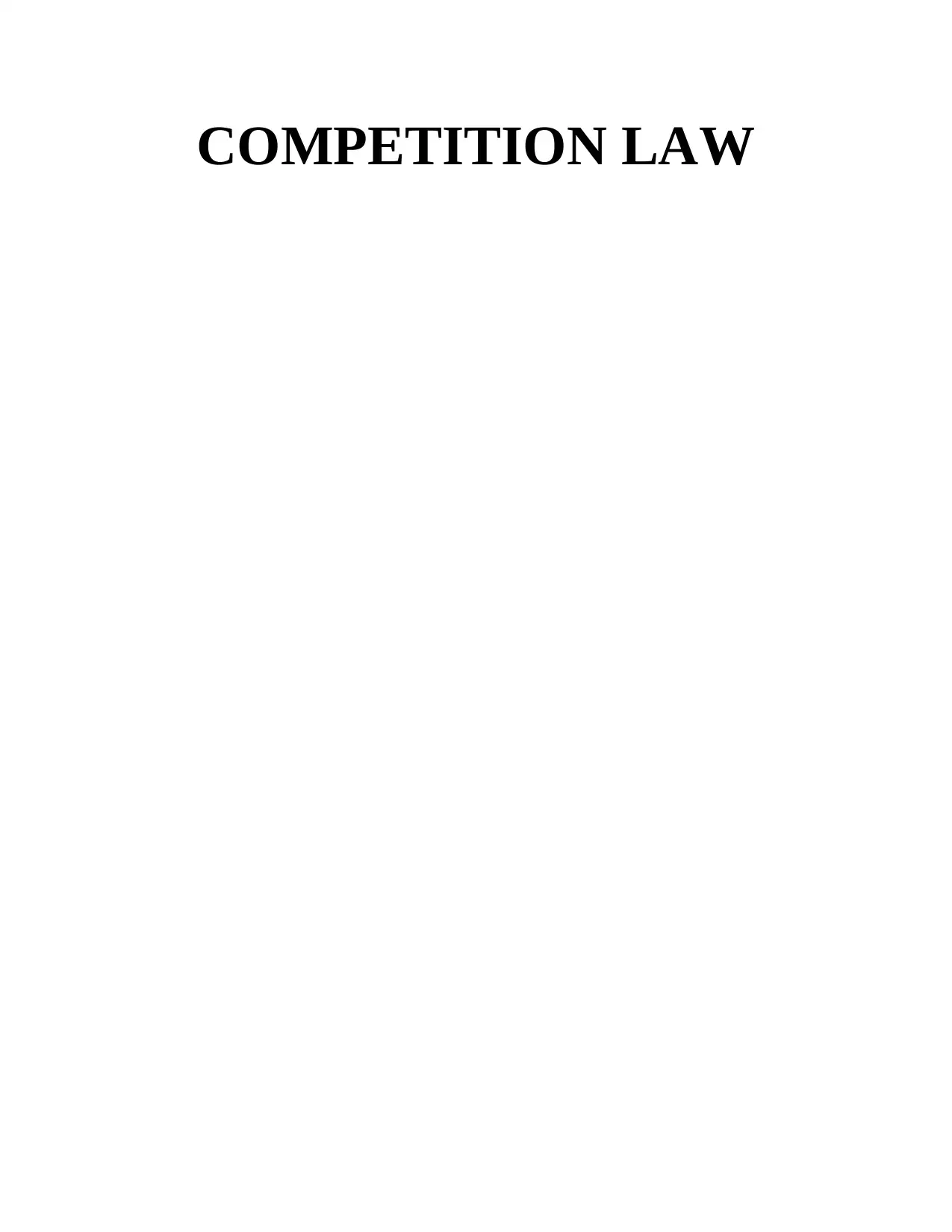
COMPETITION LAW
Paraphrase This Document
Need a fresh take? Get an instant paraphrase of this document with our AI Paraphraser
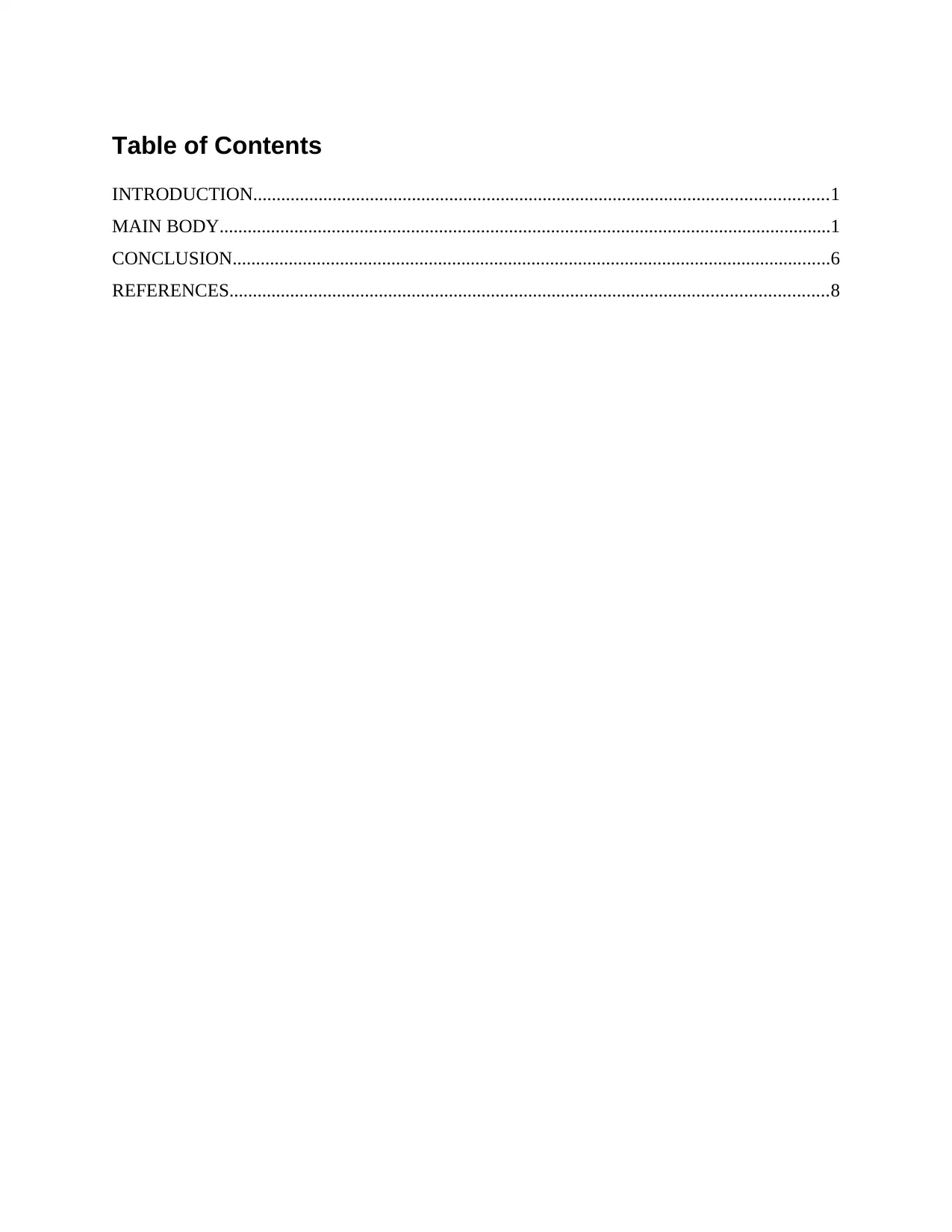
Table of Contents
INTRODUCTION...........................................................................................................................1
MAIN BODY...................................................................................................................................1
CONCLUSION................................................................................................................................6
REFERENCES................................................................................................................................8
INTRODUCTION...........................................................................................................................1
MAIN BODY...................................................................................................................................1
CONCLUSION................................................................................................................................6
REFERENCES................................................................................................................................8
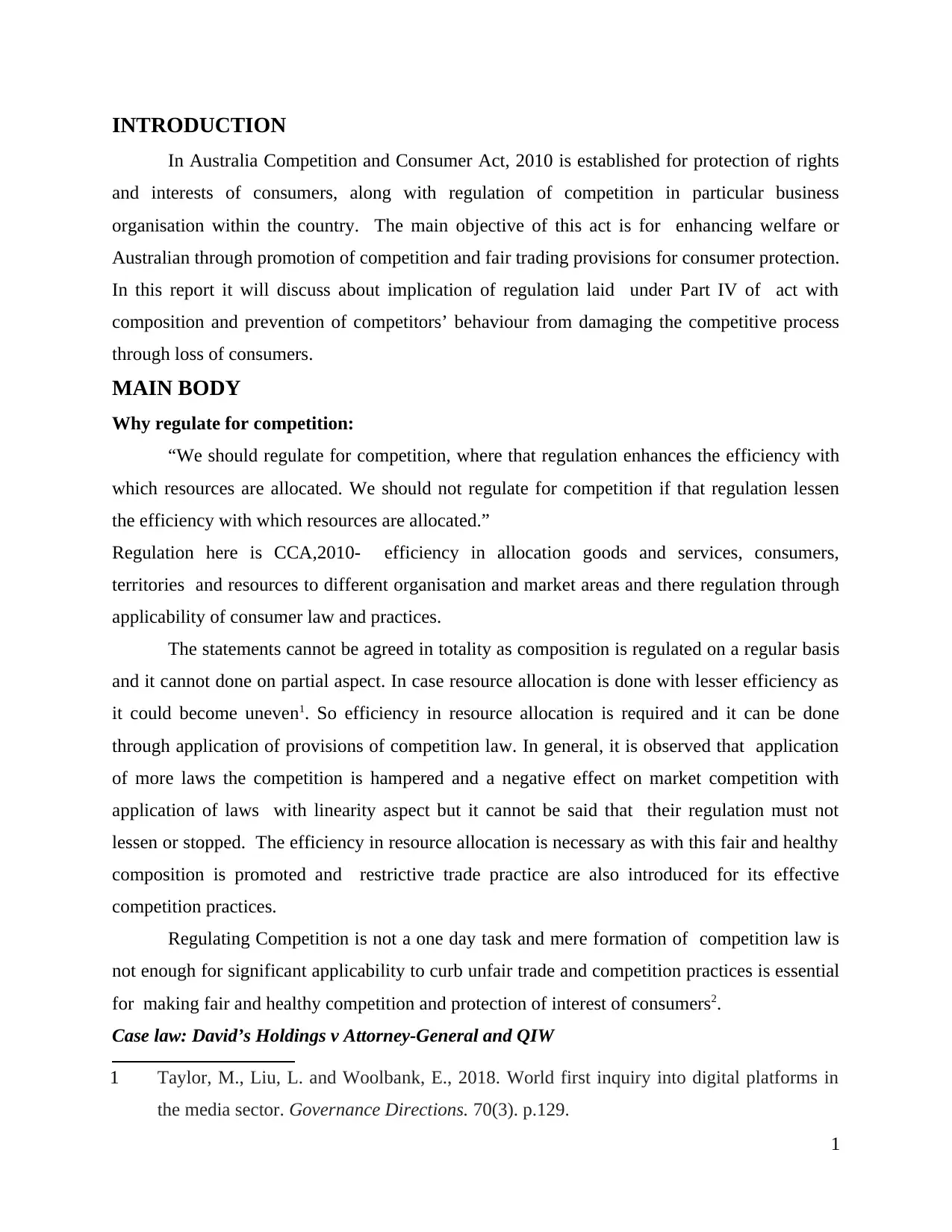
INTRODUCTION
In Australia Competition and Consumer Act, 2010 is established for protection of rights
and interests of consumers, along with regulation of competition in particular business
organisation within the country. The main objective of this act is for enhancing welfare or
Australian through promotion of competition and fair trading provisions for consumer protection.
In this report it will discuss about implication of regulation laid under Part IV of act with
composition and prevention of competitors’ behaviour from damaging the competitive process
through loss of consumers.
MAIN BODY
Why regulate for competition:
“We should regulate for competition, where that regulation enhances the efficiency with
which resources are allocated. We should not regulate for competition if that regulation lessen
the efficiency with which resources are allocated.”
Regulation here is CCA,2010- efficiency in allocation goods and services, consumers,
territories and resources to different organisation and market areas and there regulation through
applicability of consumer law and practices.
The statements cannot be agreed in totality as composition is regulated on a regular basis
and it cannot done on partial aspect. In case resource allocation is done with lesser efficiency as
it could become uneven1. So efficiency in resource allocation is required and it can be done
through application of provisions of competition law. In general, it is observed that application
of more laws the competition is hampered and a negative effect on market competition with
application of laws with linearity aspect but it cannot be said that their regulation must not
lessen or stopped. The efficiency in resource allocation is necessary as with this fair and healthy
composition is promoted and restrictive trade practice are also introduced for its effective
competition practices.
Regulating Competition is not a one day task and mere formation of competition law is
not enough for significant applicability to curb unfair trade and competition practices is essential
for making fair and healthy competition and protection of interest of consumers2.
Case law: David’s Holdings v Attorney-General and QIW
1 Taylor, M., Liu, L. and Woolbank, E., 2018. World first inquiry into digital platforms in
the media sector. Governance Directions. 70(3). p.129.
1
In Australia Competition and Consumer Act, 2010 is established for protection of rights
and interests of consumers, along with regulation of competition in particular business
organisation within the country. The main objective of this act is for enhancing welfare or
Australian through promotion of competition and fair trading provisions for consumer protection.
In this report it will discuss about implication of regulation laid under Part IV of act with
composition and prevention of competitors’ behaviour from damaging the competitive process
through loss of consumers.
MAIN BODY
Why regulate for competition:
“We should regulate for competition, where that regulation enhances the efficiency with
which resources are allocated. We should not regulate for competition if that regulation lessen
the efficiency with which resources are allocated.”
Regulation here is CCA,2010- efficiency in allocation goods and services, consumers,
territories and resources to different organisation and market areas and there regulation through
applicability of consumer law and practices.
The statements cannot be agreed in totality as composition is regulated on a regular basis
and it cannot done on partial aspect. In case resource allocation is done with lesser efficiency as
it could become uneven1. So efficiency in resource allocation is required and it can be done
through application of provisions of competition law. In general, it is observed that application
of more laws the competition is hampered and a negative effect on market competition with
application of laws with linearity aspect but it cannot be said that their regulation must not
lessen or stopped. The efficiency in resource allocation is necessary as with this fair and healthy
composition is promoted and restrictive trade practice are also introduced for its effective
competition practices.
Regulating Competition is not a one day task and mere formation of competition law is
not enough for significant applicability to curb unfair trade and competition practices is essential
for making fair and healthy competition and protection of interest of consumers2.
Case law: David’s Holdings v Attorney-General and QIW
1 Taylor, M., Liu, L. and Woolbank, E., 2018. World first inquiry into digital platforms in
the media sector. Governance Directions. 70(3). p.129.
1
⊘ This is a preview!⊘
Do you want full access?
Subscribe today to unlock all pages.

Trusted by 1+ million students worldwide
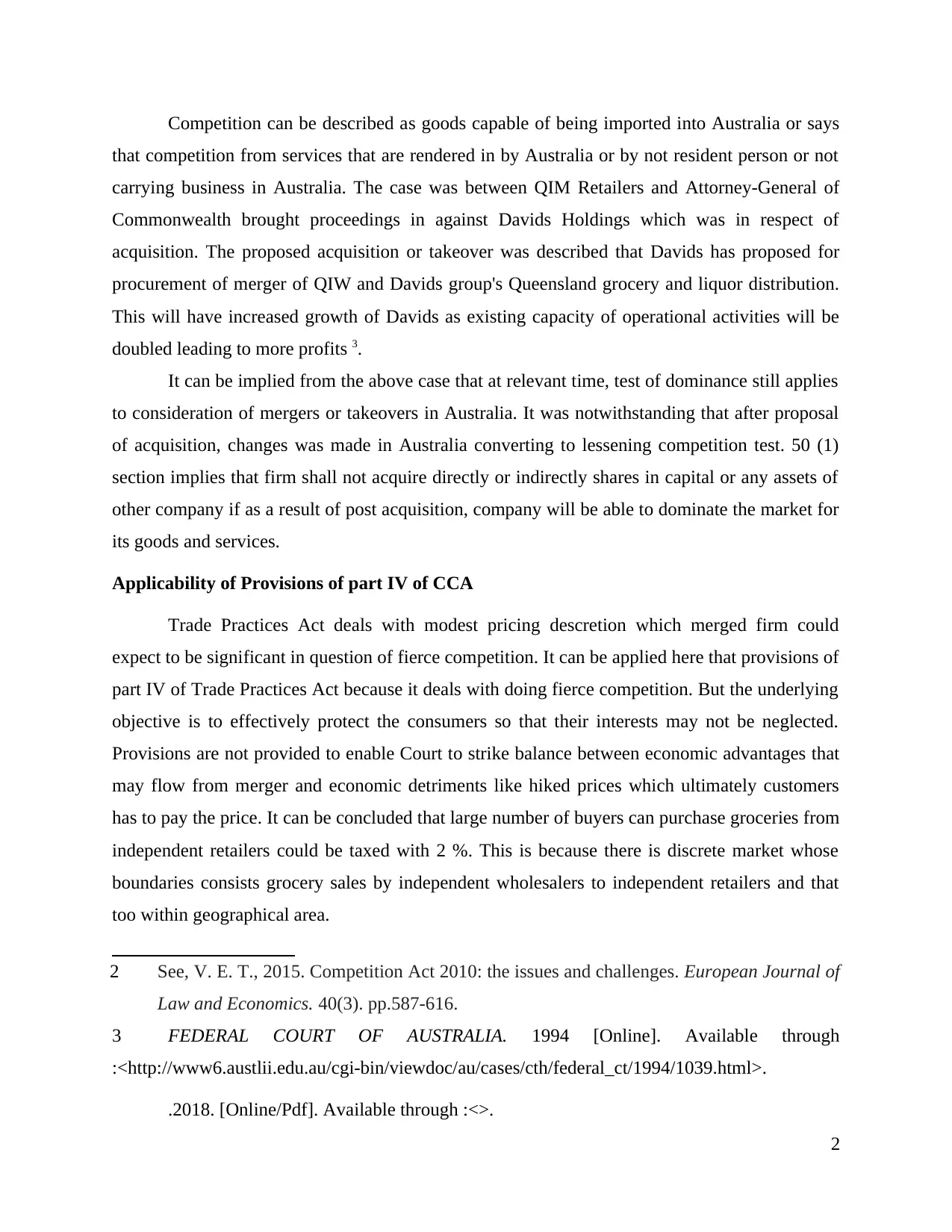
Competition can be described as goods capable of being imported into Australia or says
that competition from services that are rendered in by Australia or by not resident person or not
carrying business in Australia. The case was between QIM Retailers and Attorney-General of
Commonwealth brought proceedings in against Davids Holdings which was in respect of
acquisition. The proposed acquisition or takeover was described that Davids has proposed for
procurement of merger of QIW and Davids group's Queensland grocery and liquor distribution.
This will have increased growth of Davids as existing capacity of operational activities will be
doubled leading to more profits 3.
It can be implied from the above case that at relevant time, test of dominance still applies
to consideration of mergers or takeovers in Australia. It was notwithstanding that after proposal
of acquisition, changes was made in Australia converting to lessening competition test. 50 (1)
section implies that firm shall not acquire directly or indirectly shares in capital or any assets of
other company if as a result of post acquisition, company will be able to dominate the market for
its goods and services.
Applicability of Provisions of part IV of CCA
Trade Practices Act deals with modest pricing descretion which merged firm could
expect to be significant in question of fierce competition. It can be applied here that provisions of
part IV of Trade Practices Act because it deals with doing fierce competition. But the underlying
objective is to effectively protect the consumers so that their interests may not be neglected.
Provisions are not provided to enable Court to strike balance between economic advantages that
may flow from merger and economic detriments like hiked prices which ultimately customers
has to pay the price. It can be concluded that large number of buyers can purchase groceries from
independent retailers could be taxed with 2 %. This is because there is discrete market whose
boundaries consists grocery sales by independent wholesalers to independent retailers and that
too within geographical area.
2 See, V. E. T., 2015. Competition Act 2010: the issues and challenges. European Journal of
Law and Economics. 40(3). pp.587-616.
3 FEDERAL COURT OF AUSTRALIA. 1994 [Online]. Available through
:<http://www6.austlii.edu.au/cgi-bin/viewdoc/au/cases/cth/federal_ct/1994/1039.html>.
.2018. [Online/Pdf]. Available through :<>.
2
that competition from services that are rendered in by Australia or by not resident person or not
carrying business in Australia. The case was between QIM Retailers and Attorney-General of
Commonwealth brought proceedings in against Davids Holdings which was in respect of
acquisition. The proposed acquisition or takeover was described that Davids has proposed for
procurement of merger of QIW and Davids group's Queensland grocery and liquor distribution.
This will have increased growth of Davids as existing capacity of operational activities will be
doubled leading to more profits 3.
It can be implied from the above case that at relevant time, test of dominance still applies
to consideration of mergers or takeovers in Australia. It was notwithstanding that after proposal
of acquisition, changes was made in Australia converting to lessening competition test. 50 (1)
section implies that firm shall not acquire directly or indirectly shares in capital or any assets of
other company if as a result of post acquisition, company will be able to dominate the market for
its goods and services.
Applicability of Provisions of part IV of CCA
Trade Practices Act deals with modest pricing descretion which merged firm could
expect to be significant in question of fierce competition. It can be applied here that provisions of
part IV of Trade Practices Act because it deals with doing fierce competition. But the underlying
objective is to effectively protect the consumers so that their interests may not be neglected.
Provisions are not provided to enable Court to strike balance between economic advantages that
may flow from merger and economic detriments like hiked prices which ultimately customers
has to pay the price. It can be concluded that large number of buyers can purchase groceries from
independent retailers could be taxed with 2 %. This is because there is discrete market whose
boundaries consists grocery sales by independent wholesalers to independent retailers and that
too within geographical area.
2 See, V. E. T., 2015. Competition Act 2010: the issues and challenges. European Journal of
Law and Economics. 40(3). pp.587-616.
3 FEDERAL COURT OF AUSTRALIA. 1994 [Online]. Available through
:<http://www6.austlii.edu.au/cgi-bin/viewdoc/au/cases/cth/federal_ct/1994/1039.html>.
.2018. [Online/Pdf]. Available through :<>.
2
Paraphrase This Document
Need a fresh take? Get an instant paraphrase of this document with our AI Paraphraser
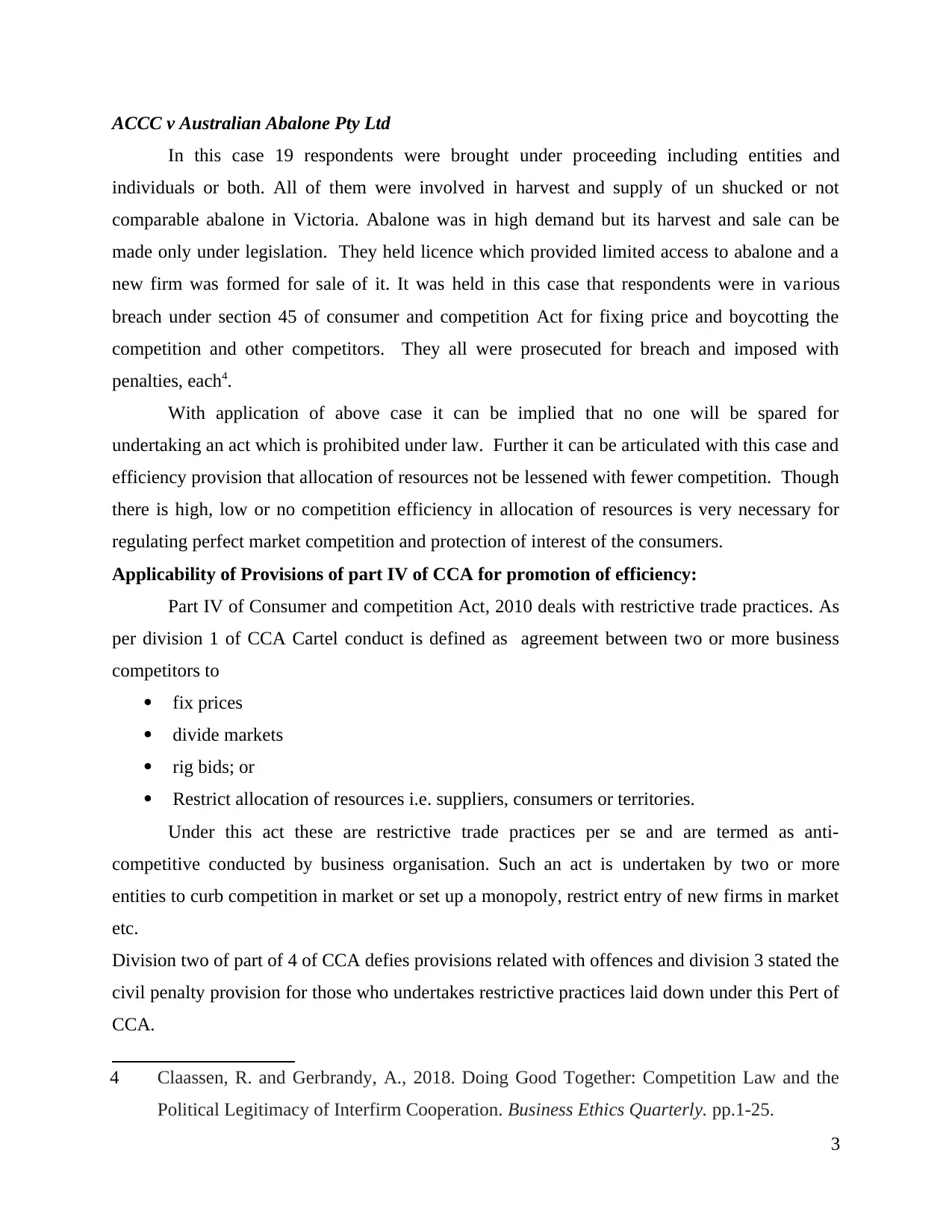
ACCC v Australian Abalone Pty Ltd
In this case 19 respondents were brought under proceeding including entities and
individuals or both. All of them were involved in harvest and supply of un shucked or not
comparable abalone in Victoria. Abalone was in high demand but its harvest and sale can be
made only under legislation. They held licence which provided limited access to abalone and a
new firm was formed for sale of it. It was held in this case that respondents were in va rious
breach under section 45 of consumer and competition Act for fixing price and boycotting the
competition and other competitors. They all were prosecuted for breach and imposed with
penalties, each4.
With application of above case it can be implied that no one will be spared for
undertaking an act which is prohibited under law. Further it can be articulated with this case and
efficiency provision that allocation of resources not be lessened with fewer competition. Though
there is high, low or no competition efficiency in allocation of resources is very necessary for
regulating perfect market competition and protection of interest of the consumers.
Applicability of Provisions of part IV of CCA for promotion of efficiency:
Part IV of Consumer and competition Act, 2010 deals with restrictive trade practices. As
per division 1 of CCA Cartel conduct is defined as agreement between two or more business
competitors to
fix prices
divide markets
rig bids; or
Restrict allocation of resources i.e. suppliers, consumers or territories.
Under this act these are restrictive trade practices per se and are termed as anti-
competitive conducted by business organisation. Such an act is undertaken by two or more
entities to curb competition in market or set up a monopoly, restrict entry of new firms in market
etc.
Division two of part of 4 of CCA defies provisions related with offences and division 3 stated the
civil penalty provision for those who undertakes restrictive practices laid down under this Pert of
CCA.
4 Claassen, R. and Gerbrandy, A., 2018. Doing Good Together: Competition Law and the
Political Legitimacy of Interfirm Cooperation. Business Ethics Quarterly. pp.1-25.
3
In this case 19 respondents were brought under proceeding including entities and
individuals or both. All of them were involved in harvest and supply of un shucked or not
comparable abalone in Victoria. Abalone was in high demand but its harvest and sale can be
made only under legislation. They held licence which provided limited access to abalone and a
new firm was formed for sale of it. It was held in this case that respondents were in va rious
breach under section 45 of consumer and competition Act for fixing price and boycotting the
competition and other competitors. They all were prosecuted for breach and imposed with
penalties, each4.
With application of above case it can be implied that no one will be spared for
undertaking an act which is prohibited under law. Further it can be articulated with this case and
efficiency provision that allocation of resources not be lessened with fewer competition. Though
there is high, low or no competition efficiency in allocation of resources is very necessary for
regulating perfect market competition and protection of interest of the consumers.
Applicability of Provisions of part IV of CCA for promotion of efficiency:
Part IV of Consumer and competition Act, 2010 deals with restrictive trade practices. As
per division 1 of CCA Cartel conduct is defined as agreement between two or more business
competitors to
fix prices
divide markets
rig bids; or
Restrict allocation of resources i.e. suppliers, consumers or territories.
Under this act these are restrictive trade practices per se and are termed as anti-
competitive conducted by business organisation. Such an act is undertaken by two or more
entities to curb competition in market or set up a monopoly, restrict entry of new firms in market
etc.
Division two of part of 4 of CCA defies provisions related with offences and division 3 stated the
civil penalty provision for those who undertakes restrictive practices laid down under this Pert of
CCA.
4 Claassen, R. and Gerbrandy, A., 2018. Doing Good Together: Competition Law and the
Political Legitimacy of Interfirm Cooperation. Business Ethics Quarterly. pp.1-25.
3
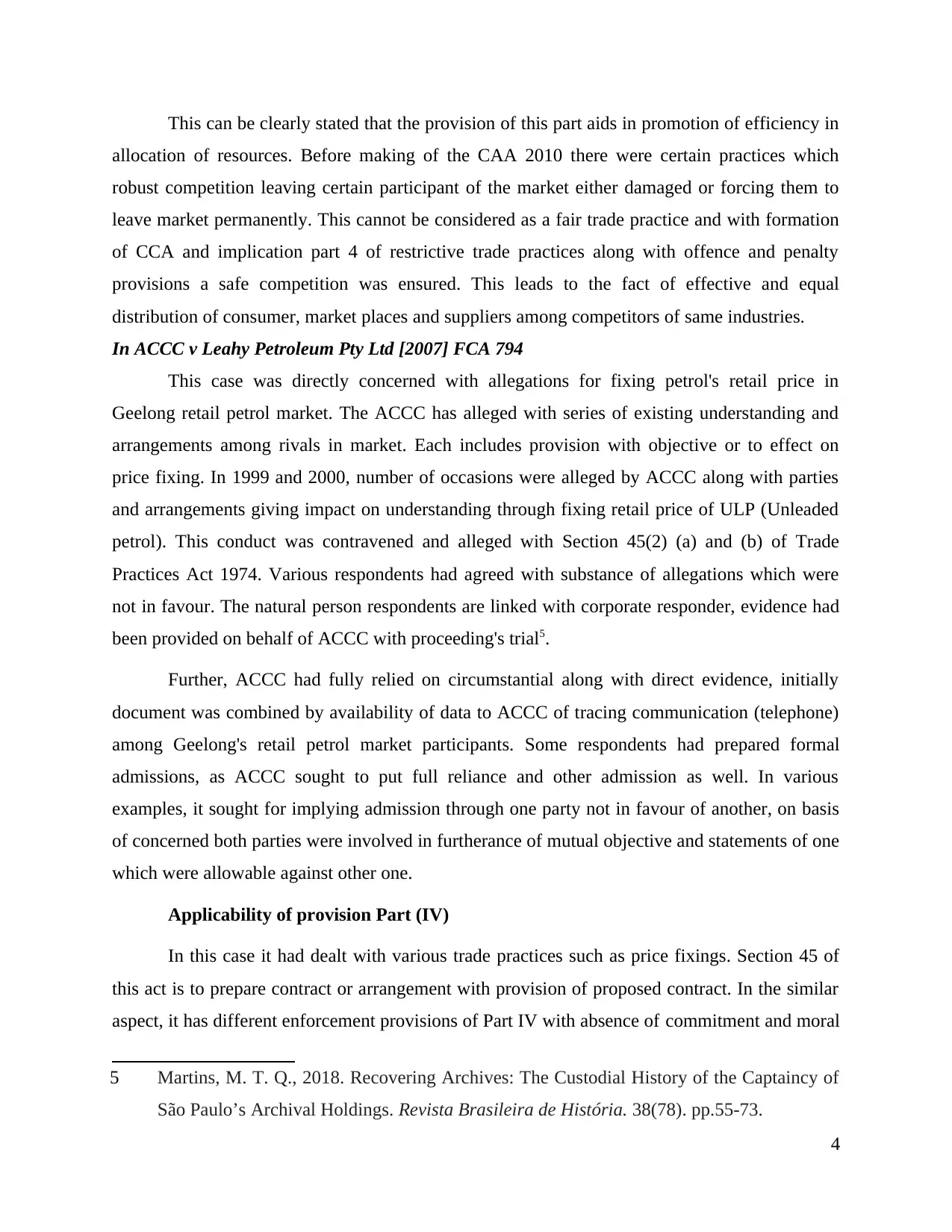
This can be clearly stated that the provision of this part aids in promotion of efficiency in
allocation of resources. Before making of the CAA 2010 there were certain practices which
robust competition leaving certain participant of the market either damaged or forcing them to
leave market permanently. This cannot be considered as a fair trade practice and with formation
of CCA and implication part 4 of restrictive trade practices along with offence and penalty
provisions a safe competition was ensured. This leads to the fact of effective and equal
distribution of consumer, market places and suppliers among competitors of same industries.
In ACCC v Leahy Petroleum Pty Ltd [2007] FCA 794
This case was directly concerned with allegations for fixing petrol's retail price in
Geelong retail petrol market. The ACCC has alleged with series of existing understanding and
arrangements among rivals in market. Each includes provision with objective or to effect on
price fixing. In 1999 and 2000, number of occasions were alleged by ACCC along with parties
and arrangements giving impact on understanding through fixing retail price of ULP (Unleaded
petrol). This conduct was contravened and alleged with Section 45(2) (a) and (b) of Trade
Practices Act 1974. Various respondents had agreed with substance of allegations which were
not in favour. The natural person respondents are linked with corporate responder, evidence had
been provided on behalf of ACCC with proceeding's trial5.
Further, ACCC had fully relied on circumstantial along with direct evidence, initially
document was combined by availability of data to ACCC of tracing communication (telephone)
among Geelong's retail petrol market participants. Some respondents had prepared formal
admissions, as ACCC sought to put full reliance and other admission as well. In various
examples, it sought for implying admission through one party not in favour of another, on basis
of concerned both parties were involved in furtherance of mutual objective and statements of one
which were allowable against other one.
Applicability of provision Part (IV)
In this case it had dealt with various trade practices such as price fixings. Section 45 of
this act is to prepare contract or arrangement with provision of proposed contract. In the similar
aspect, it has different enforcement provisions of Part IV with absence of commitment and moral
5 Martins, M. T. Q., 2018. Recovering Archives: The Custodial History of the Captaincy of
São Paulo’s Archival Holdings. Revista Brasileira de História. 38(78). pp.55-73.
4
allocation of resources. Before making of the CAA 2010 there were certain practices which
robust competition leaving certain participant of the market either damaged or forcing them to
leave market permanently. This cannot be considered as a fair trade practice and with formation
of CCA and implication part 4 of restrictive trade practices along with offence and penalty
provisions a safe competition was ensured. This leads to the fact of effective and equal
distribution of consumer, market places and suppliers among competitors of same industries.
In ACCC v Leahy Petroleum Pty Ltd [2007] FCA 794
This case was directly concerned with allegations for fixing petrol's retail price in
Geelong retail petrol market. The ACCC has alleged with series of existing understanding and
arrangements among rivals in market. Each includes provision with objective or to effect on
price fixing. In 1999 and 2000, number of occasions were alleged by ACCC along with parties
and arrangements giving impact on understanding through fixing retail price of ULP (Unleaded
petrol). This conduct was contravened and alleged with Section 45(2) (a) and (b) of Trade
Practices Act 1974. Various respondents had agreed with substance of allegations which were
not in favour. The natural person respondents are linked with corporate responder, evidence had
been provided on behalf of ACCC with proceeding's trial5.
Further, ACCC had fully relied on circumstantial along with direct evidence, initially
document was combined by availability of data to ACCC of tracing communication (telephone)
among Geelong's retail petrol market participants. Some respondents had prepared formal
admissions, as ACCC sought to put full reliance and other admission as well. In various
examples, it sought for implying admission through one party not in favour of another, on basis
of concerned both parties were involved in furtherance of mutual objective and statements of one
which were allowable against other one.
Applicability of provision Part (IV)
In this case it had dealt with various trade practices such as price fixings. Section 45 of
this act is to prepare contract or arrangement with provision of proposed contract. In the similar
aspect, it has different enforcement provisions of Part IV with absence of commitment and moral
5 Martins, M. T. Q., 2018. Recovering Archives: The Custodial History of the Captaincy of
São Paulo’s Archival Holdings. Revista Brasileira de História. 38(78). pp.55-73.
4
⊘ This is a preview!⊘
Do you want full access?
Subscribe today to unlock all pages.

Trusted by 1+ million students worldwide
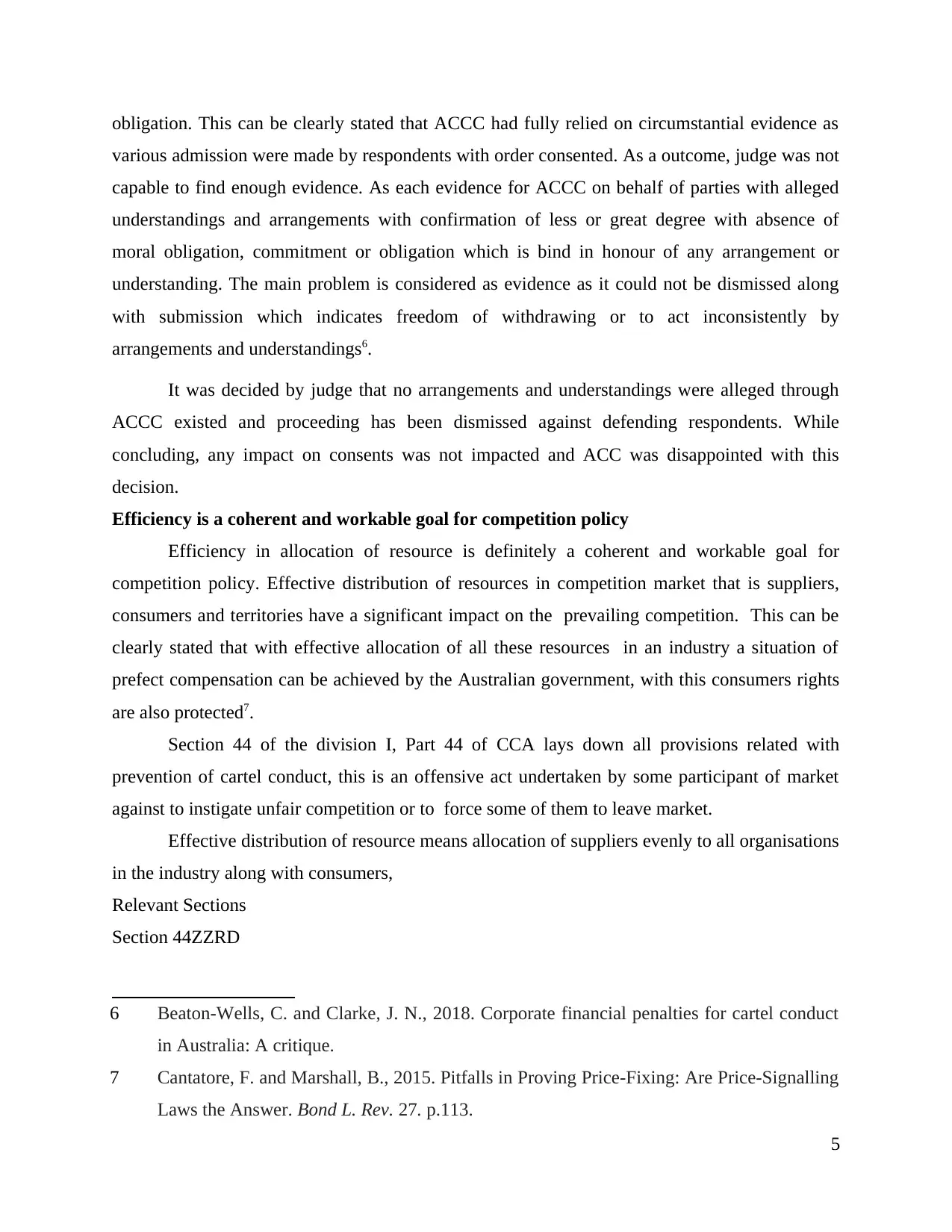
obligation. This can be clearly stated that ACCC had fully relied on circumstantial evidence as
various admission were made by respondents with order consented. As a outcome, judge was not
capable to find enough evidence. As each evidence for ACCC on behalf of parties with alleged
understandings and arrangements with confirmation of less or great degree with absence of
moral obligation, commitment or obligation which is bind in honour of any arrangement or
understanding. The main problem is considered as evidence as it could not be dismissed along
with submission which indicates freedom of withdrawing or to act inconsistently by
arrangements and understandings6.
It was decided by judge that no arrangements and understandings were alleged through
ACCC existed and proceeding has been dismissed against defending respondents. While
concluding, any impact on consents was not impacted and ACC was disappointed with this
decision.
Efficiency is a coherent and workable goal for competition policy
Efficiency in allocation of resource is definitely a coherent and workable goal for
competition policy. Effective distribution of resources in competition market that is suppliers,
consumers and territories have a significant impact on the prevailing competition. This can be
clearly stated that with effective allocation of all these resources in an industry a situation of
prefect compensation can be achieved by the Australian government, with this consumers rights
are also protected7.
Section 44 of the division I, Part 44 of CCA lays down all provisions related with
prevention of cartel conduct, this is an offensive act undertaken by some participant of market
against to instigate unfair competition or to force some of them to leave market.
Effective distribution of resource means allocation of suppliers evenly to all organisations
in the industry along with consumers,
Relevant Sections
Section 44ZZRD
6 Beaton-Wells, C. and Clarke, J. N., 2018. Corporate financial penalties for cartel conduct
in Australia: A critique.
7 Cantatore, F. and Marshall, B., 2015. Pitfalls in Proving Price-Fixing: Are Price-Signalling
Laws the Answer. Bond L. Rev. 27. p.113.
5
various admission were made by respondents with order consented. As a outcome, judge was not
capable to find enough evidence. As each evidence for ACCC on behalf of parties with alleged
understandings and arrangements with confirmation of less or great degree with absence of
moral obligation, commitment or obligation which is bind in honour of any arrangement or
understanding. The main problem is considered as evidence as it could not be dismissed along
with submission which indicates freedom of withdrawing or to act inconsistently by
arrangements and understandings6.
It was decided by judge that no arrangements and understandings were alleged through
ACCC existed and proceeding has been dismissed against defending respondents. While
concluding, any impact on consents was not impacted and ACC was disappointed with this
decision.
Efficiency is a coherent and workable goal for competition policy
Efficiency in allocation of resource is definitely a coherent and workable goal for
competition policy. Effective distribution of resources in competition market that is suppliers,
consumers and territories have a significant impact on the prevailing competition. This can be
clearly stated that with effective allocation of all these resources in an industry a situation of
prefect compensation can be achieved by the Australian government, with this consumers rights
are also protected7.
Section 44 of the division I, Part 44 of CCA lays down all provisions related with
prevention of cartel conduct, this is an offensive act undertaken by some participant of market
against to instigate unfair competition or to force some of them to leave market.
Effective distribution of resource means allocation of suppliers evenly to all organisations
in the industry along with consumers,
Relevant Sections
Section 44ZZRD
6 Beaton-Wells, C. and Clarke, J. N., 2018. Corporate financial penalties for cartel conduct
in Australia: A critique.
7 Cantatore, F. and Marshall, B., 2015. Pitfalls in Proving Price-Fixing: Are Price-Signalling
Laws the Answer. Bond L. Rev. 27. p.113.
5
Paraphrase This Document
Need a fresh take? Get an instant paraphrase of this document with our AI Paraphraser
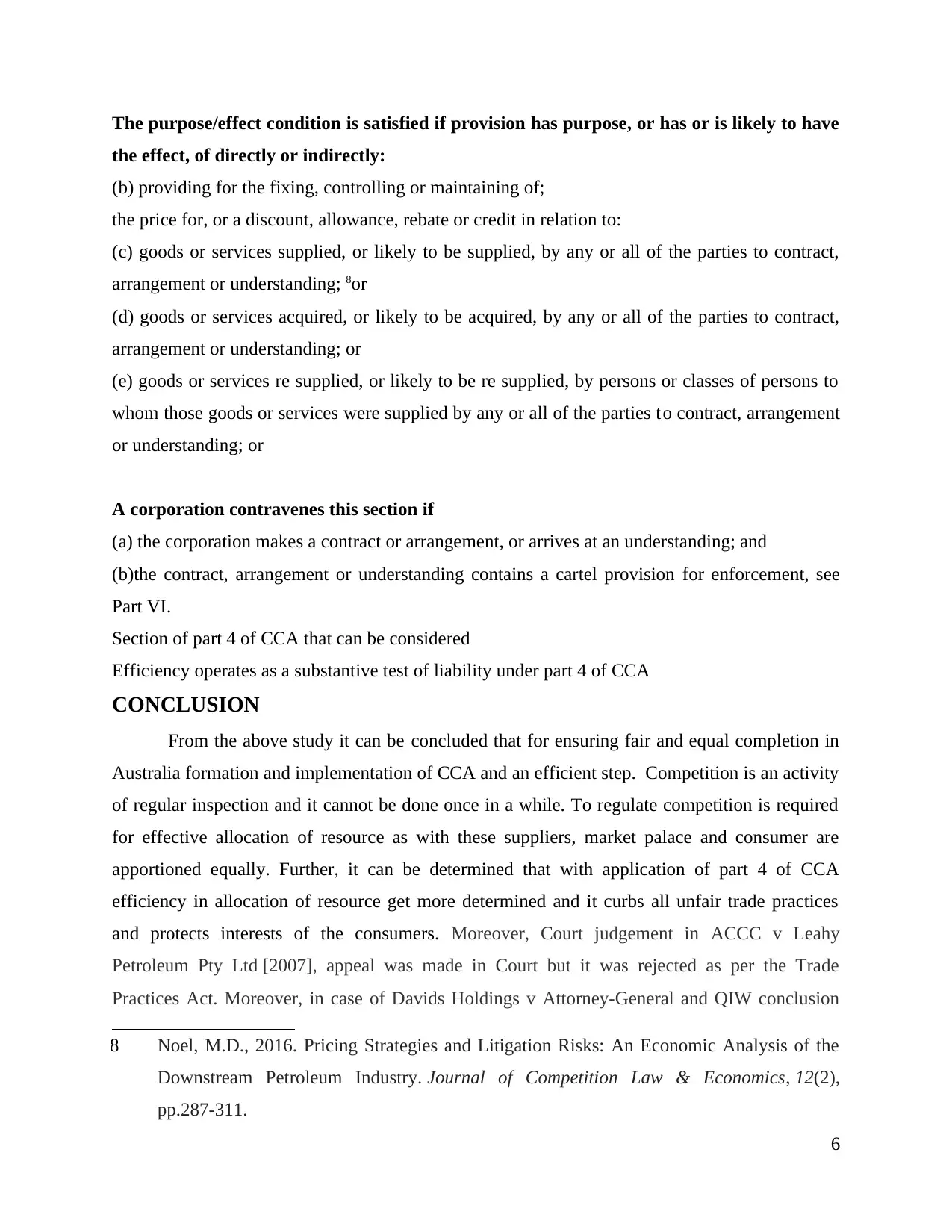
The purpose/effect condition is satisfied if provision has purpose, or has or is likely to have
the effect, of directly or indirectly:
(b) providing for the fixing, controlling or maintaining of;
the price for, or a discount, allowance, rebate or credit in relation to:
(c) goods or services supplied, or likely to be supplied, by any or all of the parties to contract,
arrangement or understanding; 8or
(d) goods or services acquired, or likely to be acquired, by any or all of the parties to contract,
arrangement or understanding; or
(e) goods or services re supplied, or likely to be re supplied, by persons or classes of persons to
whom those goods or services were supplied by any or all of the parties to contract, arrangement
or understanding; or
A corporation contravenes this section if
(a) the corporation makes a contract or arrangement, or arrives at an understanding; and
(b)the contract, arrangement or understanding contains a cartel provision for enforcement, see
Part VI.
Section of part 4 of CCA that can be considered
Efficiency operates as a substantive test of liability under part 4 of CCA
CONCLUSION
From the above study it can be concluded that for ensuring fair and equal completion in
Australia formation and implementation of CCA and an efficient step. Competition is an activity
of regular inspection and it cannot be done once in a while. To regulate competition is required
for effective allocation of resource as with these suppliers, market palace and consumer are
apportioned equally. Further, it can be determined that with application of part 4 of CCA
efficiency in allocation of resource get more determined and it curbs all unfair trade practices
and protects interests of the consumers. Moreover, Court judgement in ACCC v Leahy
Petroleum Pty Ltd [2007], appeal was made in Court but it was rejected as per the Trade
Practices Act. Moreover, in case of Davids Holdings v Attorney-General and QIW conclusion
8 Noel, M.D., 2016. Pricing Strategies and Litigation Risks: An Economic Analysis of the
Downstream Petroleum Industry. Journal of Competition Law & Economics, 12(2),
pp.287-311.
6
the effect, of directly or indirectly:
(b) providing for the fixing, controlling or maintaining of;
the price for, or a discount, allowance, rebate or credit in relation to:
(c) goods or services supplied, or likely to be supplied, by any or all of the parties to contract,
arrangement or understanding; 8or
(d) goods or services acquired, or likely to be acquired, by any or all of the parties to contract,
arrangement or understanding; or
(e) goods or services re supplied, or likely to be re supplied, by persons or classes of persons to
whom those goods or services were supplied by any or all of the parties to contract, arrangement
or understanding; or
A corporation contravenes this section if
(a) the corporation makes a contract or arrangement, or arrives at an understanding; and
(b)the contract, arrangement or understanding contains a cartel provision for enforcement, see
Part VI.
Section of part 4 of CCA that can be considered
Efficiency operates as a substantive test of liability under part 4 of CCA
CONCLUSION
From the above study it can be concluded that for ensuring fair and equal completion in
Australia formation and implementation of CCA and an efficient step. Competition is an activity
of regular inspection and it cannot be done once in a while. To regulate competition is required
for effective allocation of resource as with these suppliers, market palace and consumer are
apportioned equally. Further, it can be determined that with application of part 4 of CCA
efficiency in allocation of resource get more determined and it curbs all unfair trade practices
and protects interests of the consumers. Moreover, Court judgement in ACCC v Leahy
Petroleum Pty Ltd [2007], appeal was made in Court but it was rejected as per the Trade
Practices Act. Moreover, in case of Davids Holdings v Attorney-General and QIW conclusion
8 Noel, M.D., 2016. Pricing Strategies and Litigation Risks: An Economic Analysis of the
Downstream Petroleum Industry. Journal of Competition Law & Economics, 12(2),
pp.287-311.
6
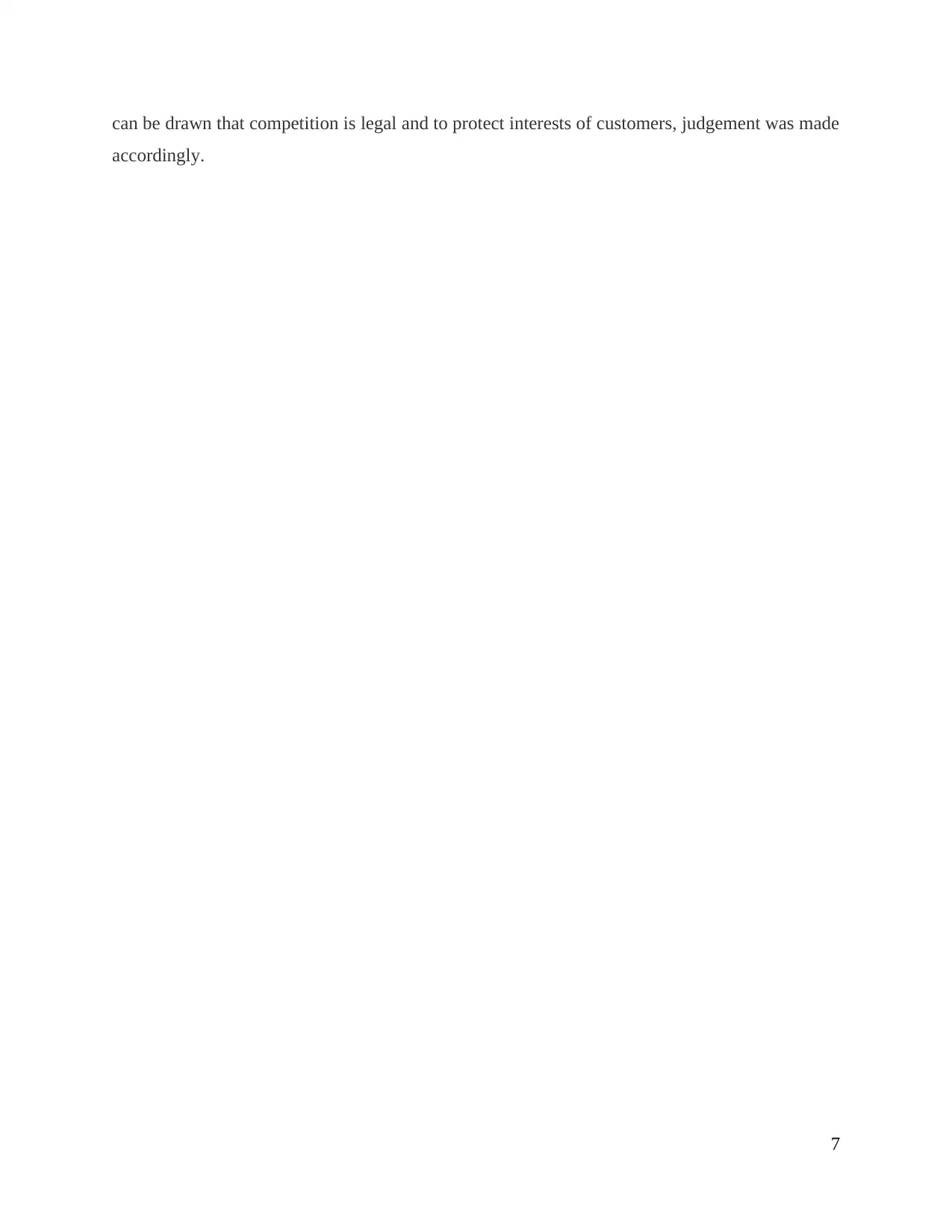
can be drawn that competition is legal and to protect interests of customers, judgement was made
accordingly.
7
accordingly.
7
⊘ This is a preview!⊘
Do you want full access?
Subscribe today to unlock all pages.

Trusted by 1+ million students worldwide
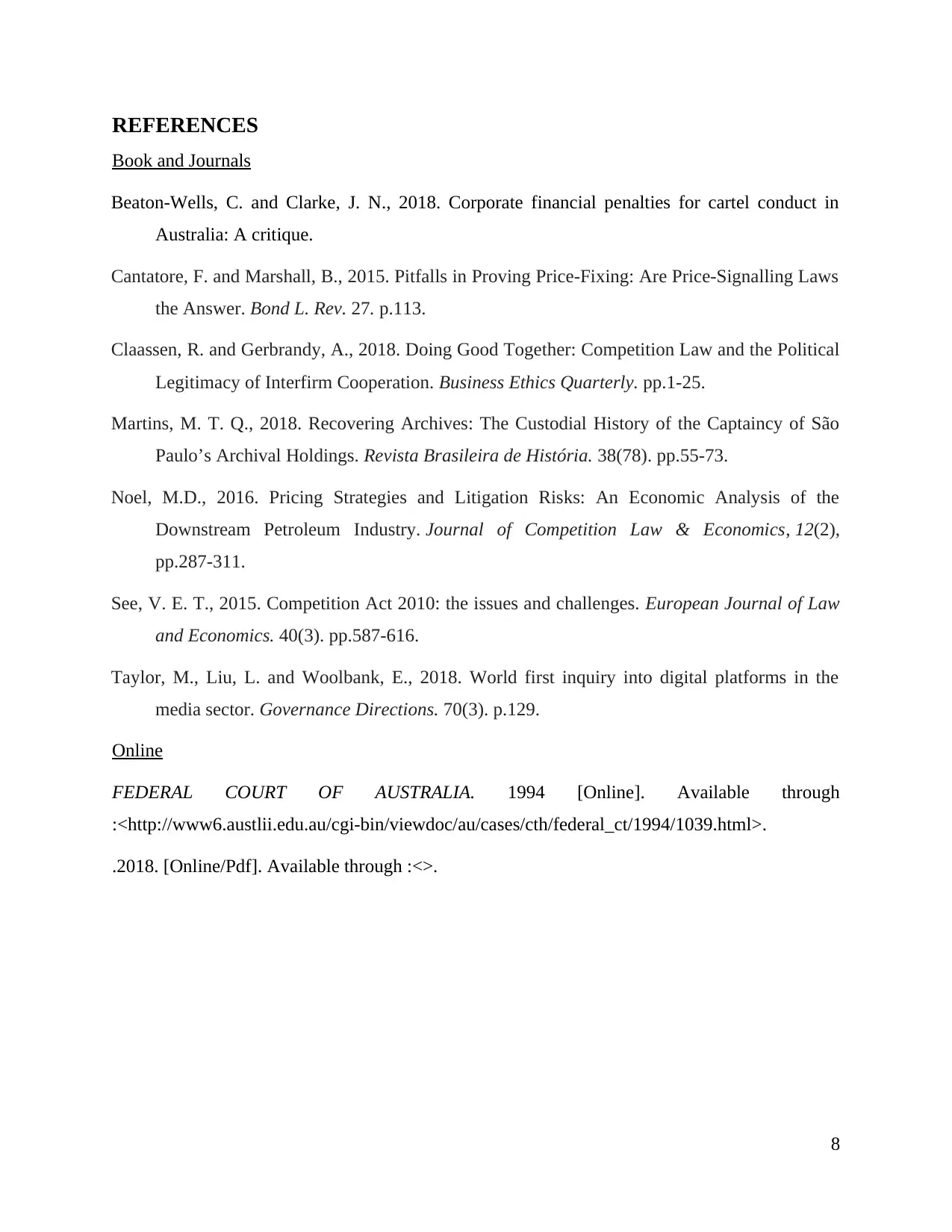
REFERENCES
Book and Journals
Beaton-Wells, C. and Clarke, J. N., 2018. Corporate financial penalties for cartel conduct in
Australia: A critique.
Cantatore, F. and Marshall, B., 2015. Pitfalls in Proving Price-Fixing: Are Price-Signalling Laws
the Answer. Bond L. Rev. 27. p.113.
Claassen, R. and Gerbrandy, A., 2018. Doing Good Together: Competition Law and the Political
Legitimacy of Interfirm Cooperation. Business Ethics Quarterly. pp.1-25.
Martins, M. T. Q., 2018. Recovering Archives: The Custodial History of the Captaincy of São
Paulo’s Archival Holdings. Revista Brasileira de História. 38(78). pp.55-73.
Noel, M.D., 2016. Pricing Strategies and Litigation Risks: An Economic Analysis of the
Downstream Petroleum Industry. Journal of Competition Law & Economics, 12(2),
pp.287-311.
See, V. E. T., 2015. Competition Act 2010: the issues and challenges. European Journal of Law
and Economics. 40(3). pp.587-616.
Taylor, M., Liu, L. and Woolbank, E., 2018. World first inquiry into digital platforms in the
media sector. Governance Directions. 70(3). p.129.
Online
FEDERAL COURT OF AUSTRALIA. 1994 [Online]. Available through
:<http://www6.austlii.edu.au/cgi-bin/viewdoc/au/cases/cth/federal_ct/1994/1039.html>.
.2018. [Online/Pdf]. Available through :<>.
8
Book and Journals
Beaton-Wells, C. and Clarke, J. N., 2018. Corporate financial penalties for cartel conduct in
Australia: A critique.
Cantatore, F. and Marshall, B., 2015. Pitfalls in Proving Price-Fixing: Are Price-Signalling Laws
the Answer. Bond L. Rev. 27. p.113.
Claassen, R. and Gerbrandy, A., 2018. Doing Good Together: Competition Law and the Political
Legitimacy of Interfirm Cooperation. Business Ethics Quarterly. pp.1-25.
Martins, M. T. Q., 2018. Recovering Archives: The Custodial History of the Captaincy of São
Paulo’s Archival Holdings. Revista Brasileira de História. 38(78). pp.55-73.
Noel, M.D., 2016. Pricing Strategies and Litigation Risks: An Economic Analysis of the
Downstream Petroleum Industry. Journal of Competition Law & Economics, 12(2),
pp.287-311.
See, V. E. T., 2015. Competition Act 2010: the issues and challenges. European Journal of Law
and Economics. 40(3). pp.587-616.
Taylor, M., Liu, L. and Woolbank, E., 2018. World first inquiry into digital platforms in the
media sector. Governance Directions. 70(3). p.129.
Online
FEDERAL COURT OF AUSTRALIA. 1994 [Online]. Available through
:<http://www6.austlii.edu.au/cgi-bin/viewdoc/au/cases/cth/federal_ct/1994/1039.html>.
.2018. [Online/Pdf]. Available through :<>.
8
1 out of 10
Related Documents
Your All-in-One AI-Powered Toolkit for Academic Success.
+13062052269
info@desklib.com
Available 24*7 on WhatsApp / Email
![[object Object]](/_next/static/media/star-bottom.7253800d.svg)
Unlock your academic potential
Copyright © 2020–2025 A2Z Services. All Rights Reserved. Developed and managed by ZUCOL.





